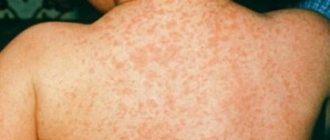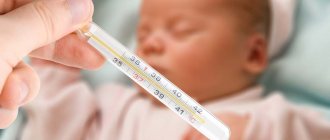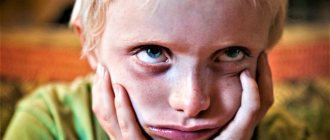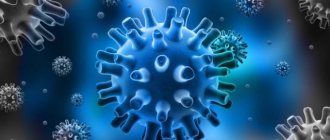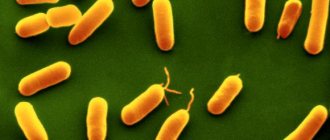General information
Meningitis in children is a neuroinfection that primarily causes damage to the soft meninges of the brain and spinal cord;
occurring with the development of general infectious, cerebral, meningeal symptoms and inflammatory changes in the cerebrospinal fluid. In the structure of pediatrics and children's infectious pathology, increased attention is paid to meningitis, which is explained by frequent organic damage to the central nervous system, high mortality from this pathology, and severe medical and social consequences. Meningitis in children
Complications
Complications of meningitis include:
- strabismus;
- loss of vision;
- paralysis;
- pronounced developmental delays in children;
- bedsores.
The best prevention of meningitis is strengthening the immune system (hardening, healthy nutrition, hygiene). It is important to promptly treat any viral diseases.
The duration of treatment depends on the form and degree of the disease. If the patient is treated late, the patient can be saved, but the rehabilitation period can take up to one year.
The first signs of meningitis in children
The incubation period is 2-10 days, the first signs of meningitis in children appear within 4-6 days after infection.
How does meningitis begin:
- a sharp increase in temperature, severe vomiting, signs of severe dehydration appear - symptoms are characteristic of serous meningitis;
- the child throws his head back strongly, arches his back:
- photophobia, intolerance to sharp sounds;
- the skin becomes pale, the nasolabial triangle turns blue;
- shortness of breath, increased heart rate;
- severe headache, discomfort increases with pressure on the upper lip, central part of the forehead, eyelids;
- severe thirst, refusal to eat;
- diarrhea, abdominal pain, bloating - such symptoms appear if pathogenic viruses enter the body with food or water;
- rash in the form of large spots.
To independently recognize a dangerous disease, you can carry out a simple preliminary diagnosis.
If you try to tilt your head to your chest, the baby’s legs will involuntarily bend at the knees; if the meninges are inflamed, the child cannot fully straighten the previously bent leg at the knee and hip joint.
Signs of brain inflammation:
- when pressing on the cheek under the cheekbone, the shoulders involuntarily rise;
- while lying on your back, pull up one leg, the second limb will also rise involuntarily;
- when pressing on the pubic area, both legs impulsively bend;
- the child complains of a severe headache, tinnitus, hides under the blanket, bright lights and loud sounds are unpleasant to him;
- the elevated temperature lasts for several days, falls and rises again;
- a rash appears on the body in the form of bright red, burgundy single or group spots, the skin becomes very sensitive;
- the baby becomes delirious in his sleep, chills and convulsive symptoms appear.
After 5 years, the first signs of meningitis may be respiratory symptoms - redness of the throat, pain when swallowing.
Additionally, confusion is observed, the child cannot answer simple questions, is delirious, the whites of the eyes acquire a yellowish tint, the face swells, turns red, and muscle hypertonicity is observed.
Headache
The most common cerebral symptom is headache. Only a person who has had it can describe how a headache with meningitis hurts. Classic meningeal headache is diffuse, very intense, according to the subjective assessments of some patients, unbearable, it bursts from the inside and puts pressure on the eyes and ears. At the height of pain, vomiting may occur, either without relief or bringing it for a short period of time. In children, vomiting with meningitis is usually “gushing.”
The headache worsens with bright light, loud sounds, touch, and changes in body position. This phenomenon is called hyperesthesia. The headache will not always be of the nature described above; in practice, there are patients complaining of pain in the back of the head and neck, or patients with a tolerable but debilitating headache. It all depends on the pathogen and cause of the disease, as well as the stage of the process.
Mechanism of disease development
The most common etiology of inflammation of the meninges is a viral infection. Of course, bacteria can also initiate the development of pathology, but they are much less common. In most cases, it is the etiological factor that determines the symptoms of meningitis. The disease is more common in children. This is due to the fact that the blood-brain barrier in them performs its protective function much worse than in adults.
So why does a rise in temperature occur with meningitis? What symptoms accompany the disease? Most often, the disease begins acutely and resembles a cold.
This occurs due to the release of substances called pyrogens into the blood.
Later, severe headaches begin, which are caused by increased intracranial pressure, and then chills and discomfort in the muscles and joints.
In rare cases, meningitis develops without fever, but such a course of the disease requires a combination of many causes and contributing factors. It is the high temperature that allows the specialist to suspect the presence of infectious pathogens in the organ.
One of the main signs of meningitis in babies under one year of age is the bulging of a large fontanel.
How to recognize meningitis in children under one year of age:
- Lessage's symptom - if you lift the child's armpits, he will reflexively throw back his head and pull his legs towards his stomach;
- severe diarrhea, regurgitation;
- the child is excited, constantly cries, due to the increased sensitivity of the skin, any touch causes pain;
- high temperature that does not decrease after taking antipyretics;
- convulsions;
- decreased muscle tone;
- a rash appears on the mucous membranes;
- loss of consciousness is possible.
Causes
Meningitis begins due to penetration of pathogenic microorganisms into the bloodstream, cerebral fluid or brain structure:
- Viruses (enteroviruses, herpes simplex, cytomegalovirus, arbovirus, mumps P virus).
- Bacteria (intestinal, Haemophilus influenzae, tubercle bacilli, staphylococci, listeria, pneumococci, meningococci, streptococci).
- Fungi (Candida, Coccidioides immitis).
- Spirochetes (bacteria that cause leptospirosis, relapsing fever, syphilis, borreliosis).
Routes of transmission: airborne droplets, oral-fecal, contact and household methods of transmission, as well as by passing through the birth canal, insect/rodent bites. Through the blood and lymph, the infection enters the body and begins to actively multiply, leading to serious intoxication and an inflammatory process.
Another factor that provokes the onset of meningitis is depressed immunity, which can be weakened by:
- Past infectious diseases.
- Chronic diseases, including diabetes, tuberculosis.
- Severe stress.
- Poor, unbalanced nutrition.
- Alcohol and smoking abuse.
- Back and head injuries.
- Illiterate use of medicines.
- Vitamin deficiency, hypothermia.
Meningitis can begin as a complication after surgical procedures (for example, an infection enters the blood through a catheter).
When a pathogenic infection penetrates the membrane of the brain, an inflammatory process begins, which causes changes and swelling of the membrane. Since it is not able to stretch, the cerebellum and medulla oblongata shift, this leads to swelling of the brain itself, and there is a threat of death to the patient.
In the chronic form, swelling and symptoms are less pronounced.
There is a misconception that the cause of the development of meningitis is always general hypothermia of the body, or being outside in cold weather without a hat. In fact, there are many more reasons:
- Penetration of viruses and bacteria into the pericerebral fluid and directly into the lining of the brain itself.
- Meningococci from the genus Neisseria (the causative agent of meningitis and sepsis), as well as pneumococcus, which causes pneumonia. Being in the nose and throat, these bacteria do not cause any harm, however, when they penetrate the blood and from it reach the brain, they cause the development of the disease.
- Streptococcus class B. Occurs either during childbirth or immediately after it.
- Strokes and head injuries (traumatic meningitis).
The disease can be transmitted by airborne droplets, through insect bites, through food, dirty water, and during the birth process.
Pathogenesis of meningitis in children
In primary meningitis in children, the entry point for infection most often is the mucous membranes of the respiratory or gastrointestinal tract. Penetration of the pathogen into the cranial cavity and meninges occurs through hematogenous, segmental-vascular or contact routes. Severe toxemia and an increase in the level of biologically active substances create conditions for increasing the permeability of vascular membranes, the blood-brain barrier, the penetration of microorganisms and their toxins into the central nervous system with the development of serous, serous-purulent or purulent inflammation of the meninges.
The accumulation of inflammatory exudate causes irritation of the choroid plexuses of the ventricles of the brain, which is accompanied by an increase in the production of cerebrospinal fluid and an increase in intracranial pressure. The main clinical manifestations of meningitis in children are associated with the development of hypertensive-hydrocephalic syndrome. The consequence of the expansion of the liquor spaces and compression of brain tissue is the deterioration of perfusion, the development of hypoxia, the release of fluid from the vascular bed and the occurrence of cerebral edema.
With proper treatment of meningitis in children, in the phase of reverse development, resorption of inflammatory exudate occurs, normalization of liquor production and intracranial pressure. In the case of irrational treatment of meningitis in children, the organization of purulent exudate and the formation of fibrosis may occur, which will result in a violation of liquor dynamics with the development of hydrocephalus.
Spinal shape
The occurrence of symptoms of spinal cord damage indicates the spinal form of tuberculous meningitis. In this case, the functions of the pelvic organs are primarily affected in the form of urinary and fecal incontinence, severe weakness in the legs.
The course of the tuberculous form of meningitis can be lightning fast, which leads to the death of the patient without treatment within 4-8 weeks, or it can be sluggishly progressive, which can become a chronic type of disease with the development of pelvic disorders, dementia, and hydrocephalus.
The article provided comprehensive information about whether meningitis can occur without fever. We hope that it will be useful for you and will protect you from a dangerous illness.
Classification of meningitis in children
Depending on the origin, pathogen, area of damage, and characteristics of the course, different types of meningitis are distinguished.
Origin
Analyzing the genesis of the disease, primary and secondary meningitis are distinguished. Primary appears as an independent disease in a child who was healthy before infection. The cause may be meningococcal bacteria or various viruses. Secondary develops as a complication of a disease, for example, otitis or sinusitis.
Damage area
The disease can affect different areas of the brain. If the arachnoid membranes become inflamed, they speak of arachnoiditis. This is the rarest form of the disease.
Damage to the hard membranes occurs with pachymeningitis. Leptomeningitis occurs due to pathology of the arachnoid and soft membranes.
Character of the current
Depending on the characteristics of the course and speed of occurrence, fulminant, acute, subacute and chronic forms are distinguished. With a fulminant course, the disease develops so quickly that even timely treatment does not always help.
Signs of meningitis infection in a child appear less than a day after the first nonspecific symptoms are detected. Infectious-toxic shock occurs in most cases. Such dynamics are usually characteristic of bacterial meningitis.

